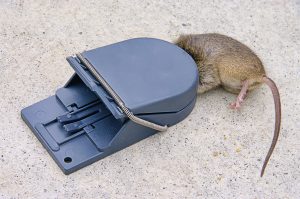Mice are a very common infestation and are also very skilled at hiding in plain sight. Many people can go through years of having a mouse infestation without even realizing it. Mice are a danger to the health and well being of the people and animals that live in the infested house. They can cause food poisoning and other dangerous illnesses by defecating and urinating on your food and their feces, when dry can flake and become air born, possibly infecting people in the home with the Hantavirus, which is a very serious and deadly respiratory illness. Touching a mouse is even more dangerous. They tend to sleep in a nest filled with old rotting food and their urine and feces so touching them with bare hands is a big no-no. If the mouse is caught in a snap trap and you plan on using the trap again then there are some important steps you will have to go through.

If you have mice in your home then snap traps are not the only option. You can use a variety of humane capture traps, glue traps which are effective but not recommended for the faint of heart as the mice caught on it will begin cannibalizing each other when they get hungry. You can use a battery-powered electric zap trap that will kill the mouse without you even having to touch it and there is always poison. The best poison options are domestic rodenticides that cause desiccation in the mouse. If the mouse does not have any water left in their body they can safely die in the walls and you will never notice them again. No smell, no biological hazard and no chance of even seeing them. This is a less potent but just as effective version of commercial-grade rodenticide blocks used by professional exterminators. The domestic grade rodenticide comes in hollow pellets so it can be strung on a line or locked into a domestic bait station. This will end any interaction you have to have with the mice and will be faster, more effective and safer for you than having to empty snap traps of mice.

